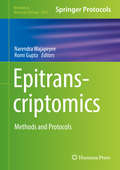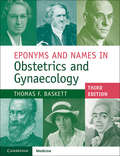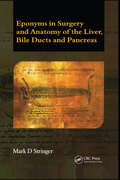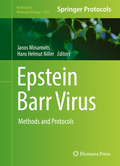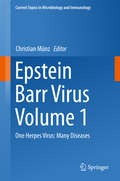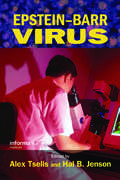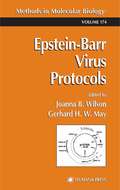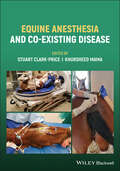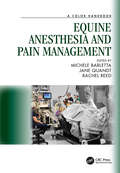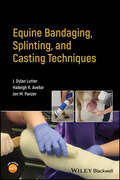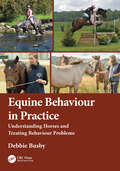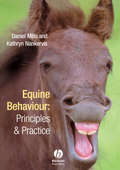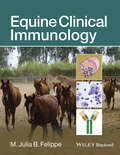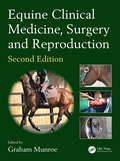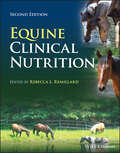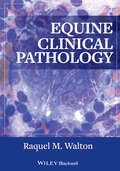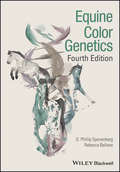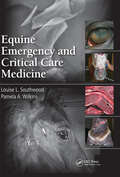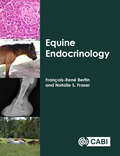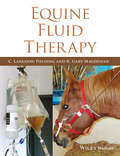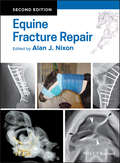- Table View
- List View
Epitranscriptomics: Methods and Protocols (Methods in Molecular Biology #1870)
by Narendra Wajapeyee Romi GuptaThis volume provides readers with the latest technologies to study changes in the epitranscriptome. The protocols described in this book explore both targeted and unbiased high-throughput analysis associated with post-transcriptional RNA modification. The chapters in this book also cover specific topics such as transcriptome-wide detection of 5-methylcytosine; HAMR; iRNA-2OM; genome-wide annotation of circRNAs; immune-northern blotting; and detection and quantification of pseudouridine in RNA. Written in the highly successful Methods in Molecular Biology series format, chapters include introductions to their respective topics, lists of the necessary materials and reagents, step-by-step, readily reproducible laboratory protocols, and tips on troubleshooting and avoiding known pitfalls.Authoritative and comprehensive, Epitranscriptomics: Methods and Protocols is an important resource for both expert and novice scientists who are interested in learning more about this field.
Eponyms and Names in Obstetrics and Gynaecology: Eponyms And Names In Obstetrics And Gynaecology
by Thomas F. BaskettFew specialties have a longer or richer eponymous background than obstetrics and gynaecology. Eponyms add a human side to an increasingly technical profession and represent the historic tradition and language of the speciality. This collection aims to perpetuate the names and contributions of pioneers and offer introductory profiles to the founders in whose steps we follow. This third edition includes 26 new entries, as well as expanded detail, illustration and quotation for existing entries. Biographical data and historical and medical context are discussed for each of the 391 names, with reference to 34 countries, reflecting the field's far reaching origins. More than 1700 original references feature, alongside an extensive bibliography of more than 2500 linked references to assist readers searching for more detailed information. This is a volume for physicians, midwives, medical historians, medical ethicists and all those interested in the history and evolution of obstetrical and gynaecological treatment.
Eponyms in Surgery and Anatomy of the Liver, Bile Ducts and Pancreas
by Mark D StringerFor surgeons, physicians, and anatomists involved in the management and study of disorders of the liver, bile ducts and pancreas, eponyms are part of everyday communication. They help to describe anatomical features, operative procedures, surgical instruments, and diseases. Unfortunately, many have become distorted or are inaccurately applied. Few of us understand their derivation or the remarkable people and controversies behind them.This book explores the origins of seventy eponyms in the field of hepatobiliary and pancreatic surgery and anatomy. Each section is deliberately short and intended for quick reference, providing accurate information about the origin of the eponym and the figure behind it.Meticulously researched, and beautifully illustrated with more than 150 photographs, Eponyms in Surgery and Anatomy of the Liver, Bile Ducts and Pancreas is aimed at surgeons, physicians and anatomists, and is sure to enrich the reader's historical perspective of this fascinating branch of surgery and anatomy.
Epstein Barr Virus
by Hans Helmut Niller Janos MinarovitsThis volume explores data from the applications of molecular biological methods and the applications of recent immunological and cytogenetic methods in Epstein-Barr Virus (EBV) that will offer readers possible new solutions to the unresolved problems in the EBV field. Chapters in this book cover topics such as: viral life cycle, latency, EBV-associated diseases and EBV diagnostics; in vitro methods including organotypic cultures for the analysis of EBV-epithelial cell interactions; identification of the interacting viral and cellular proteins using affinity purification-mass spectrometry methods; 3D telomere FISH; transcription analysis using high-throughput RNA sequencing, qPCR and nuclear run-on assay; analysis of viral and cellular microRNAs; isolation and characterization of exosomes and the assessment of their function; characterization of the viral genome by terminal repeat analysis and sequencing; the use of chromatin immunoprecipitation coupled sequencing (ChIP-Seq) for the analysis of Zta-DNA interactions; epigenetic analysis by bisulfite sequencing and ChIP; novel in vivo models for the study of EBV infection; and how immunological, virological, tissue culture and molecular methods can be combined to yield Good Manufacturing Practice-compliant EBV-specific T cells for the immunotherapy of EBV-associated post-transplant lymphoproliferative diseases (PTLD). Written in the highly successful Methods in Molecular Biology series format, chapters include introductions to their respective topics, lists of the necessary materials and reagents, step-by-step, readily reproducible laboratory protocols, and tips on troubleshooting and avoiding known pitfalls. Cutting-edge and comprehensive, Epstein Barr-Virus: Methods and Protocols is a valuable resource for anyone who is interested in this fascinating and evolving field.
Epstein Barr Virus Volume 2
by Christian MünzEpstein Barr virus (EBV) was discovered as the first human tumor virus around 50 years ago. Since its discovery in Burkitt's lymphoma it has been associated with various other malignancies, infectious mononucleosis and even autoimmune diseases. The two book volumes on EBV summarize the first 50 years of research on this tumor virus, starting with historical perspectives on discovery, oncogenicity and immune control, reviewing the role that the virus plays in the various associated diseases and concluding with a discussion on how the immune system keeps persistent EBV infection under control in healthy EBV carriers and can be used to treat EBV associated diseases. The respective 32 chapters are written by international experts from three continents for health care providers, biomedical researchers and patients that are affected by EBV. The assembled knowledge should help to understand EBV associated diseases better and to develop EBV specific vaccination in the near future.
Epstein-Barr Virus
by Martin GardnerFilling a gap in the literature, this guide analyzes EBV infection and all of its associated disorders including infectious mononucleosis, Burkitt lymphoma, and Hodgkin's disease. Opening with a historical introduction, the reference progresses from molecular virology, epidemiology, immunology, and pathology to clinical presentation, diagnosis, dis
Epstein-Barr Virus Protocols
by Joanna B. Wilson Gerhard H. MayJoanna Wilson and Gerhard May have assembled a collection of the key molecular biology protocols used in the analysis of Epstein-Barr virus (EBV), along with a series of valuable immunology, cell biology, and transgenic mouse protocols. These readily reproducible techniques include methods for gene expression with mini-EBV plasmids, for expression analysis by FISH, for EBV detection and quantitation, and for cell proliferation and death assays. In addition, there are EBV-based vectors, an up-to-date map of EBV, a comprehensive table of available latent protein antisera, and assays from in vitro to cell to organ to organism levels. Timely and highly practical, Epstein-Barr Virus Protocols provides powerful tools for elucidating the life cycle of EBV and its host interactions, work that promises the emergence of major new treatments and cures for EBV associated diseases, including several forms of human cancer.
Equal Opportunity and the Case for State Sponsored Ectogenesis
by Evie KendalEctogenesis refers to the artificial gestation of a fetus outside the womb. Despite certain advantages for women's reproductive liberty, feminist groups remain divided regarding this technology. This book argues that reproduction imposes unjust burdens on women, and thus the ideals of equal opportunity demand continued research into ectogenesis.
Equalising Opportunities, Minimising Oppression: A Critical Review of Anti-Discriminatory Policies in Health and Social Welfare
by Dylan Ronald Tomlinson Winston TrewAnti-Racist Practice (ARP), Anti-Discriminatory Practice (ADP) and Anti-Oppressive Practice (AOP) form a trinity of concepts, nested into one another, which have evolved in welfare services over the last fifteen years. They tend to have developed as forms of practice panaceas and as a result have been subject to both unrealistic expectations and, at times, to political ridicule. This book clarifies the distinctions between three key concepts - ARP, ADP and AOP. Critically and constructively analysing these three approaches to practice it reappraises their potential in the light of emerging equality issues in the health service With contributions from leading teachers and practitioners in the field, Equalising Opportunities provides students and practitioners in health and social care with a clear overview of an area where there is much confusion and imperfect understanding.
Equality within Our Lifetimes: How Laws and Policies Can Close—or Widen—Gender Gaps in Economies Worldwide
by Jody Heymann Aleta Sprague Amy RaubA free ebook version of this title is available through Luminos, University of California Press’s Open Access publishing program. Visit www.luminosoa.org to learn more. Well into the twenty-first century, achieving gender equality in the economy remains unfinished business. Worldwide, women’s employment, income, and leadership opportunities lag men’s. Building and using a one-of-a-kind database that covers 193 countries, this book systematically analyzes how far we’ve come and how far we have to go in adopting evidence-based solutions to close the gaps. Spanning topics including girls’ education, employment discrimination of all kinds, sexual harassment, and caregiving needs across the life course, the authors bring the findings to life through global maps, stories of laws’ impact in courts and beyond, and case studies of making change. A powerful call to action, Equality within Our Lifetimes reveals how gender equality is both feasible and urgently needed to address some of the greatest challenges of our generation.
Equine Anesthesia and Co-Existing Disease
by Stuart Clark-Price Khursheed MamaEquine Anesthesia and Co-Existing Disease offers practical guidance on anesthetizing horses with pre-existing diseases or other unique conditions. Filling a significant gap in available literature, this authoritative reference is the ideal companion to existing publications on basic management principles, equipment, and complications in equine anesthesia. Detailed chapters, co-authored by anesthesiologists and other allied specialists, offer a body-system approach to anesthesia considerations in horses presenting with a variety of disease conditions. Each chapter contains foundational knowledge such as pathophysiology or diagnostic techniques, clinical images, practical information for pharmacologic selection, and technical requirements for completion of procedures. The text covers equine anesthesia management relevant to respiratory, neuromuscular, and gastrointestinal diseases, cardiac and orthopedic procedures, diagnostic imaging and unique therapies, and more. Designed to allow quick and easy reference to vital information, this valuable clinical resource: Provides complete coverage of anesthetic management of horses with existing conditions or diseases Describes how pre-existing conditions can affect anesthesia in equine patients Includes coverage of accident and error management, induction, and recovery Discusses how anesthesia management differs for other species such as domesticated donkeys and mules Equine Anesthesia and Co-Existing Disease is a must-have reference and clinical guide for everyone involved in the anesthetization of equine patients, including equine general practitioners, anesthesiologists, specialists in related areas, residents in veterinary anesthesiology, and equine anesthesia technicians.
Equine Anesthesia and Pain Management: A Color Handbook (Veterinary Color Handbook Series)
by Rachel Reed Michele Barletta Jane QuandtEquine Anesthesia and Pain Management: A Color Handbook brings together key information for clinicians in an easy-to-use, problem-orientated format. It disseminates a wealth of knowledge about horse, donkey and mule anesthesia and pain management in a quick reference style, with a focus on clinical practice. Fifteen chapters by expert contributors cover everything from anesthetic equipment, premedication and physical restraint, to total intravenous anesthesia, inhalant anesthesia and partial intravenous anesthesia, recovery, complications and euthanasia. Over 250 superb color photographs and diagrams bring the material to life. This book will be invaluable to all those who need practical information easily to hand, whether equine practitioner, veterinary technician or nurse, or veterinary student.
Equine Bandaging, Splinting, and Casting Techniques
by J. Dylan Lutter Haileigh K. Avellar Jen M. PanzerEquine Bandaging, Splinting, and Casting Techniques A practical reference manual dealing with a vital component of clinical practice in equine medicine The application of bandages, splints, and casts is an essential part of equine surgical and veterinary care. Traditionally, however, there have been few available resources wholly dedicated to application techniques. The result is that equine veterinary practitioners learn to bandage, splint, and cast on the job, with highly variable results; some practitioners are unwilling even to attempt a cast, spurning this valuable healing tool entirely rather than attempt it from an uncertain base of knowledge. Equine Bandaging, Splinting, and Casting Techniques offers the first comprehensive reference to this specific set of techniques and their applications in equine veterinary medicine. It promises to cultivate a rigorous, clinically tested, consistent standard of care that will improve patient outcomes and long-term owner costs. It is a must-own for any veterinary practitioner who works with equine patients. Equine Bandaging, Splinting, and Casting Techniques readers will also find: Step-by-step organization guides reader smoothly through each process Practical tips and advice for improving quality and appearance of bandages and casts Over 270 color images, including clinical examples and radiographs, supplementing every listed technique Equine Bandaging, Splinting, and Casting Techniques is ideal for all veterinary practitioners, technicians, and students interested in equine care.
Equine Behaviour in Practice: Understanding Horses and Treating Behaviour Problems
by Debbie BusbyCombining an in-depth exploration of equine behaviour with clinical practice from a new progressive perspective, Equine Behaviour in Practice: Understanding Horses and Treating Behaviour Problems focuses not just on the horse’s behaviour but also on the behaviour of the human interacting with the horse. Acclaimed Clinical Equine Behaviourist Debbie Busby delivers evidence-based knowledge that will equip readers with the understanding and skills to become effective equine behaviour consultants. Supported by considered discussion of how and why horses sometimes struggle to cope, the book comprehensively explains how to consult on and treat a range of equine behaviour problems. Rather than providing a formulaic "here’s the problem; here’s how to fix it", Busby encourages readers to develop a critical biopsychosocial evaluation based on an understanding of how horses evolved, their ethological and physiological adaptations, how they learn, and how their welfare and wellbeing can be assessed. KEY FEATURES: Part 1 explains theories of equine evolution and the thin veneer of domestication Part 2 describes psychological and physiological theories of how horses learn, and how this can be applied in training and behaviour modification Part 3 illustrates this with reference to relevant legislation and widely used animal welfare models, as well as assessments of abnormal and stereotypic behaviour and practical aspects of measuring welfare Part 4 turns to the theory and practice of behaviour consulting, in three chapters divided into elements of behavioural assessment and treatment planning Part 5 examines the use of psychopharmaceuticals in behaviour therapy, discussing the roles of the behaviour consultant and the referring veterinary surgeon Bridging the gap between science and practice, this book is a must-read for equine behaviour and veterinary students, equine behaviour consultants and practitioners, horse trainers, interested leisure riders and competition riders. It will empower equine professionals to combine behavioural and welfare knowledge with counselling and coaching skills to support horse owners in a mutual flourishing, enriching the lives of both species.
Equine Behaviour: Principles and Practice
by Daniel S. Mills Kathryn J. NankervisUnderstanding the flexibility and limits of behaviour is essential to improving both the horse's welfare and its performance. This book tackles the fundamental principles which will enable owners, riders, trainers and students to understand scientific principles and apply them in practice. Subjects covered include the analysis of influences on equine behaviour, the perceptual world of the horse, learning and training techniques including the latest developments in "join-up" and "imprint training".
Equine Clinical Immunology
by M. Julia FelippeEquine Clinical Immunology offers comprehensive information on equine immunological disorders.* Provides a complete, equine-specific reference on clinical immunology * Focuses on clinically relevant information for the diagnosis and treatment of horses with immune disorders * Illustrates the concepts discussed using drawings, photographs, and tables * Presents key concepts, clinical assessment information, and treatment approaches in text boxes for ease of use * Offers a practical, clinically oriented approach ideal for equine specialists
Equine Clinical Medicine, Surgery and Reproduction, Second Edition (Manson Ser.)
by Graham MunroeThis fully-revised new edition of the bestselling Equine Clinical Medicine, Surgery and Reproduction is supported by over 1800 illustrations of the highest quality: colour photographs, radiographic and ultrasound images, and diagrams. System-based, the chapters introduce each individual system with precise information on the relevant basic anatomy and physiology, standard clinical examination techniques and useful differential diagnostic aids. This is followed by diseases and disorders that are pertinent to that system, grouped together either anatomically or based on presenting clinical signs. Each condition is described using consistent headings: definition/overview, etiology and pathophysiology, clinical presentation, diagnosis, differential diagnoses, management/treatment, and prognosis. Additional chapters deal with the foal, with wounds and behavioural problems. New to the second edition is expanded material on the musculoskeletal system, a new muscle section, updated information on reproduction, including assisted breeding and laparoscopic techniques, more information on diagnostic tests including over ground endoscopy, chest ultrasonography and head CT, and a significantly expanded surgical section. The material on equine dentistry, neurology, endocrine system and the liver has also been considerably developed. The focus throughout remains on providing clinically relevant information required for practical case management, plus sufficient background on causes and disease processes to enable readers to understand the conditions and the rationale for diagnostic and treatment options. Expert authors come together under the editorship of Dr Graham Munroe to create a textbook that will be of lasting value as a teaching and training resource for equine specialists and students in veterinary medicine and related equine courses, as well as a ready reference for non-specialist practitioners.
Equine Clinical Nutrition
by Rebecca L. RemillardEQUINE CLINICAL NUTRITION Authoritative resource on the nutritional management of horses, now incorporating the iterative learning process The second edition of Equine Clinical Nutrition is a fully updated and expanded revision of the classic student text on nutritional management of horses, covering updated nutrient recommendations, rations, feeding management, clinical nutrition and many other important topics in the field. To aid in reader comprehension, this new edition takes a new instructional approach to nutritional management using an iterative sequence of defined procedures. Divided into distinct sections for easy accessibility, this book is a comprehensive resource for feeding practices and management of healthy and sick horses alike. A thorough understanding of life stages, anatomy, physiology, and behavior underpins the practice of clinical nutrition. Sample topics covered in Equine Clinical Nutrition include: The evolution of horses to changing food supply, the importance of their microbiome, and the behavior patterns of feeding and drinking Nutrient metabolism of water, energy, protein, minerals, and vitamins, plus ration assessment, farm investigations, forages, and toxic plants Manufactured feeds, dietary supplements, USA feed regulations, and feed safety protocols Nutritional assessment of horses by life stage, recognizing pain and discomfort behaviors, and dietary management of weight and major system disorders Equine Clinical Nutrition is an essential text for students of veterinary medicine, animal science, pre-veterinary programs, and a desk reference for equine practitioners wanting practical clinical feeding recommendations. With comprehensive coverage of the topic, it is an essential text for everything related to nutrition in horses.
Equine Clinical Pathology
by Raquel M. WaltonEquine Clinical Pathology is the first complete resource for hematology and clinical chemistry in horses. Encompassing the basic principles and advanced interpretation, the book's single-species approach to pathology allows for focused coverage of the unique disease characteristics of equids. Equine Clinical Pathology is equally useful for anyone using clinical pathology as a diagnostic tool, from beginning student to experienced specialist.The heart of the book is organized by body system, making it easy to find and apply information. Chapters cover general laboratory medicine, including instruments and techniques, hematology, and proteins as well as specific organs, such as the kidney and liver. Equine Clinical Pathology is a useful bench-side reference for anyone involved in laboratory medicine for the horse.
Equine Color Genetics
by D. Phillip Sponenberg Rebecca BelloneEquine Color Genetics, Fourth Edition presents a detailed examination of the color variation in horses and donkeys and the genetic mechanisms that produce color variations. Thoroughly covers the basic colors in horses, including bay, chestnut, black, and brown Details the genetic basis of the colors built from the basic coat color, including dilutions and white patterning Provides an explanation of genetic mechanisms that determine coat color Presents a thorough revision and update, including new advances in molecular genetics, biochemistry, molecular mechanisms, genetic loci, coat colors before domestication, and more Offers a new introduction describing the principles of genetics and genomics research to help outline how knowledge is discovered and to assist the reader in understanding concepts covered in the book
Equine Emergency and Critical Care Medicine
by Louise L. Southwood Pamela A. WilkinsEarly recognition of problems by owners, appropriate first aid, and timely referral by field veterinarians improve the chance of survival for horses requiring emergency management and critical care. With a view toward improving patient outcome, Equine Emergency and Critical Care Medicine is written by a team of enthusiastic equine specialists who e
Equine Endocrinology
by François-René Bertin Natalie S FraserThis book provides a practical, clinical approach to diagnosing, treating, and managing endocrine diseases in the horse. Each chapter uses the same structure to form a user-friendly tool of information and advice on aetiology, pathophysiology, clinical presentation, diagnosis and treatment for each endocrine disorder. This book covers: - approaches to endocrine disorders; - diseases of the hypothalamo-pituitary-thyroid axis; - disorders in calcium regulation and diseases of the parathyroid gland; - diseases of the hypothalamo-pituitary-adrenocortical axes; - diseases of the endocrine pancreas and Equine Metabolic Syndrome; - hyperlipaemia and lipid metabolism disorders; and - endocrine disorders associated with the female and male reproductive systems. This book also includes material on additional endocrinopathies, such as diabetes insipidus and pheochromocytoma, and is dedicated to the fast-moving field of equine endocrinology. Written by world-leading international experts, it collates their insights and experience into approaches that prove invaluable for general equine practitioners.
Equine Exercise Physiology
by David Marlin Kathryn J. NankervisEquine exercise physiology is an area that has been subject to major scientific advances over the last 30 years, largely due to the increased availability of high-speed treadmills and techniques for recording physiological function during exercise. Despite the scientific advances, many riders and trainers are still using little more than experience and intuition to train their horses. The aim of this book is to sort the fact from the fiction for the benefit of those involved in training, managing or working with horses, and to provide an up-to-date summary of the state of play in equine exercise physiology. Scientific theories are explained from first principles, with the assumption that the reader has no previous scientific background. The book is designed to save competitors and trainers a lot of time and effort trying to extract information in piecemeal fashion from a host of reference sources. For the first time, everything you need to know about exercising and training horses is here in one text.
Equine Fluid Therapy
by K. Gary Magdesian C. Langdon FieldingEquine Fluid Therapy is the first reference to draw equine-specific fluid therapy information together into a single, comprehensive resource. Offering current information unique to horses on the research and practice of fluid, electrolyte, and acid-base disorders, the book is designed to be clinically oriented yet thorough, providing detailed strategies tailored to equine practice. With information ranging from physiology and acid-base balance to fluid therapy for specific conditions, Equine Fluid Therapy covers fluid treatments in both adult horses and foals, highlighting the unique physiologic features, conditions, and differences in foals.Well-illustrated throughout, the book begins with an overview of the physiology of fluids, electrolytes, and acid-base, then moves into practical information including equipment, monitoring techniques, fluid choices, and potential complications. A final section offers chapters on blood transfusions, colloids, parenteral nutrition, and hemodynamic monitoring. Equine Fluid Therapy is an essential reference for equine practitioners, specialists, and researchers.
Equine Fracture Repair
by Alan J. NixonOffers a long-awaited Second Edition of this comprehensive, state-of-the-art reference for fracture repair in horses The Second Edition of Equine Fracture Repair has been thoroughly revised and updated to present the most current information on fracture repair in horses. Written to be accessible, the text is logically arranged, presenting the most authoritative information on equine fracture repair with explanations of the expected outcomes. The book provides valuable insight as to whether a fracture should be repaired, the degree of difficulty of the procedure, and a wealth of practical information on surgical techniques. This fully revised Second Edition offers a valuable tool for veterinarians making clinical decisions when faced with horse fractures, covering emergency care and splinting, the most current innovative techniques in equine fracture repair, and new implant systems. With contributions from leading experts in the field, the revised edition continues to be the essential reference to the subject. This essential resource: Offers a revised edition of the most comprehensive reference on the repair of fracture in horses, with complete information on patient assessment, emergency splinting and casting, and guidance in treatment choices Includes contributions from leading experts in the field Presents information organized by fracture type for quick access Provides valuable outcome assessment with helpful discussions of the degree of difficulty to aid in case management, incorporating information on the newest techniques and implant systems Concludes with extensive information on the identification and management of complications associated with fractures and repair methods This revised and updated edition of Equine Fracture Repair continues to provide a comprehensive resource for understanding the most effective and current techniques available for the treatment of fractures in horses.
